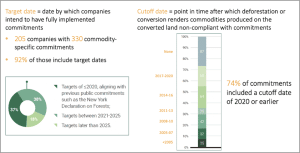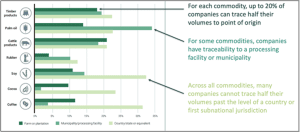From declarations by global leaders at the COP26 climate talks to the forthcoming ‘Paris agreement for nature’ expected at the COP15 biodiversity convention in Montreal later this year, the trend is clear: the time for businesses to accelerate their actions to address and disclose their impacts on nature is now.
Eliminating deforestation and conversion of other ecosystems for agriculture and forestry is central to meeting both global climate and nature goals. We are unlikely to avoid disastrous effects of climate change without halting deforestation and other natural ecosystem destruction, which account for at least 11% of human greenhouse gas emissions each year. And because forests and other natural ecosystems are also essential for biodiversity, ecosystem services, and livelihoods, halting conversion of natural ecosystems for agriculture is also an essential first step in meeting targets for nature and sustainable development.
The majority of deforestation is driven by agricultural and forestry commodity production, putting the companies that produce or source these products in the spotlight of efforts by policymakers, investors, and civil society to protect forests and support sustainable soft commodity production.
Our new report ‘From commitments to action at scale: Critical steps to achieve deforestation-free supply chains’ – published by the Accountability Framework initiative (AFi) and CDP – provides an in-depth look at company progress on the actions that are needed to deliver on deforestation-free supply chains.
It uses data disclosed through CDP’s forests questionnaire in 2021 by 675 companies that produce or source at least one of the seven commodities responsible for most commodity-driven forest loss: palm oil, timber products, cattle products, soy, natural rubber, cocoa and coffee. Our analysis included 100 producers, 241 processors, 137 traders, 378 manufacturers, and 185 retailers. Since companies often disclose on more than one commodity, the analysis includes over 1,100 commodity-specific disclosures.
Our findings show that most companies disclosing on their commodity supply chains have started to put governance and operational systems in place to mitigate deforestation and related risks. However, these systems currently lack the scale, scope, and rigor necessary to effectively address deforestation by 2025 in line with science-based climate targets. This holds true across each of the key areas of performance assessed in the report – including company commitments and policies, traceability, supplier engagement, monitoring, verification, and landscape-level collaboration.
Commitments and Policies
Two thirds of companies responding to the CDP forests questionnaire in 2021 disclosed forest-related policies, but only a third had public, company-wide no-deforestation or no-conversion commitments.
However, those companies that did have comprehensive policies tended to also include ambitious target dates and appropriate cutoff dates for deforestation and ecosystem conversion (see figure 1) indicating that leading companies see these goals as achievable.
Figure 1: Disclosed target dates and cutoff dates for corporate no-deforestation commitments

Traceability
To reduce risk and ensure the products in a supply chain are free of deforestation, ecosystem conversion, and human rights abuses, companies need to know how and where these materials were produced. While a handful of companies report having successfully implemented robust traceability systems to identify commodity origins, most companies are far from achieving traceability necessary to identify and address deforestation and conversion in their supply chains (see figure 2). Our analysis found that three-quarters of companies report having a traceability system for at least one commodity, but that only one in four disclose sufficient traceability or monitoring systems to implement commitments made or assess progress against them.
This lack of information about the origins of commodity supplies will limit companies’ abilities to reduce both their impact on ecosystems and their scope 3 greenhouse gas emissions. It also implies the need for significant new investment in traceability to meet upcoming trade regulations addressing deforestation.
Figure 2: Percentage of companies sourcing each commodity disclosing traceability of 50% or more of their commodity volumes to a given supply chain stage.

Supplier engagement
By engaging with direct and indirect suppliers, companies can provide clear expectations – along with incentives, tools, and support as needed – to enable suppliers to fulfil buyers’ commitments. We found that two-thirds of companies reported engaging with direct suppliers to manage deforestation risks but only a quarter provide technical or financial assistance. In addition, half of all traders, manufacturers, or retailers (194/390) disclosed working with their indirect suppliers to manage and mitigate deforestation risks.
As tools for supply chain mapping and supplier assessment improve and are increasingly available, these numbers could see rapid improvement for all companies up and down the supply chain. However, to achieve supply chain goals, this engagement must go beyond assessment and communication of expectations to include clear and consistent strategies to address non-compliant suppliers and to transparently manage and reduce sourcing of commodity volumes that are linked to deforestation conversion, or human rights abuses.
Toward disclosure of impacts
To improve the quality of disclosures and improve accountability overall, corporate disclosure related to supply chains is increasingly focusing on company performance and on-the-ground impact. In 2022, the CDP forests questionnaire is for the first time asking companies to disclose the proportion of their supply chain volumes that can be assessed or verified to be free from deforestation and ecosystem conversion. It also asks companies to disclose the amount of recent deforestation and conversion associated with their supply chains.
The inclusion of these indicators in CDP’s disclosure – as well as this year’s Greenhouse Gas Protocol’s guidance on measuring, accounting for and reporting on land sector emissions – will provide new visibility into companies’ deforestation footprints and associated climate impacts, as well as how companies are addressing these impacts. These types of disclosures will also become increasingly necessary to satisfy forthcoming Scope 3 GHG emissions disclosure requirements.
The Accountability Framework provides guidance on best practices for companies working to manage forestry and agricultural supply chains responsibly. By using the Framework, coupled with the CDP forests disclosure platform, companies can follow a clear pathway to rapidly scale their actions towards achieving deforestation-free supply chains and disclose their impacts on ecosystems, climate, and biodiversity.
